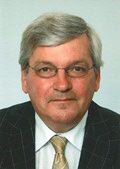J.C. Kapteyn chair for Prof. dr. Piet van der Kruit (2003)

Prof. dr. Piet van der Kruit was appointed to the J.C. Kapteyn Chair in 2003. Van der Kruit is an emeritus professor of Astronomy, and was in his career mostly involved with research and teaching on structure and dynamics of our and other galaxies. He studied in Leiden, where he used radio telescopes, and after his PhD he was a Carnegie Fellow at the Mount Wilson and Palomar Observatories in California. In 1975 he moved to Groningen where he became a professor in Astronomy in 1987. In addition he was the director of the Kapteyn Institute and a member or chair of many Dutch astronomical committees and boards, in particular chair of the NOVA and the ASTRON. He had a yearlong sabbatical at Mount Stromlo in Australia and shorter sabbaticals at the Institute of Astronomy in Cambridge, UK, and at the Space Telescope at Baltimore, US.
Astronomy
For his PhD with Professor J.H. Oort in Leiden, he studied the expansions in the central parts of our Galaxy, using the Dwingeloo Radio Telescope. After that he was among the first observers of the Westerbork Synthesis Radio Telescope, where he was involved in mapping nearby galaxies. Among others he has been credited with the breakthrough of the discovery of spiral arms in the radio in the Galaxy M51, which confirmed the density wave theory of spiral structure. His most important work has been on the structure, dynamics, stability and evolution of disks in spiral galaxies. At Palomar Observatory in California he produced some of the first maps of the velocities in spiral galaxies. He also produced some of the first detailed (photographic) surface photometry of spiral galaxies and measured for the first time the stellar motions in external galaxies. His Australian colleague Ken Freeman, with whom he did the latter work, described him as “the world expert on galactic disks”.
J.C. Kapteyn
Jacobus Cornelius Kapteyn was born in 1851. He went to study Maths and Physics at the University of Utrecht in 1868. He also received his PhD there. He was appointed professor of Astronomy at the University of Groningen, when he was 27 years old. Kapteyn was the first professor of Astronomy in Groningen. He introduced a completely new way of studying the construction of the universe. He started recording large amounts of stars using the new technology of photography. Kapteyn built a special lab for measuring and processing all the photographic recordings. It became famous around the world. The Kapteyn Institute was named after him.
| Last modified: | 23 August 2021 4.34 p.m. |
